When you look at an oyster, would you ever imagine something as beautiful as a pearl could dwell within? That’s how I feel about the painted churches! Plain on the outside; amazingly beautiful on the inside: surely these churches inspire us to want to beautiful on the inside too.
According to the Houston Chronicle, Texas hill country has more than 20 “painted” churches. When Roman Catholic Czech and German immigrants arrived in the 1800s, many settled in central Texas. Their first priorities were to build churches and schools. In an effort to make their new churches feel more like the ancient churches of their homelands, these early settlers painted the walls, altars and arches of their simple wooden sanctuaries in colorful patterns and clever tromp l’oeil images. These buildings came to be known as the Painted Churches of Texas. Our tour guide, Wanda Stanzel, is a devout convert to Catholicism, and her tour narrative was factually and spiritually detailed.
Tour Welcome — St. James
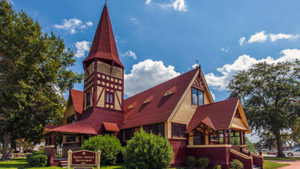 On Wednesday, we had the opportunity to experience a “field trip” to four painted churches. Our day started at St. James Episcopal Church in La Grange — not a painted church but an American adaptation of the English Queen Anne style. It was designed by Richard M. Upjohn of New York and completed in 1856. The St. James parish family treated us to coffee and kolaches, followed by a Eucharist celebrated by The Rev. Eric Hungerford, Rector of St. James. As July 11 is the Feast of St. Benedict, the homily by the Rev. Bill King (Chaplain for NAGA Triennial) focused on St. Benedict’s rule of prayer (see next page.) Church organist Jim Holmes, a longtime church member and La Grange native, gave an interesting talk on the history of the church, its architecture, and its organ.
On Wednesday, we had the opportunity to experience a “field trip” to four painted churches. Our day started at St. James Episcopal Church in La Grange — not a painted church but an American adaptation of the English Queen Anne style. It was designed by Richard M. Upjohn of New York and completed in 1856. The St. James parish family treated us to coffee and kolaches, followed by a Eucharist celebrated by The Rev. Eric Hungerford, Rector of St. James. As July 11 is the Feast of St. Benedict, the homily by the Rev. Bill King (Chaplain for NAGA Triennial) focused on St. Benedict’s rule of prayer (see next page.) Church organist Jim Holmes, a longtime church member and La Grange native, gave an interesting talk on the history of the church, its architecture, and its organ.
1 Nativity ofMary, Blessed Virgin

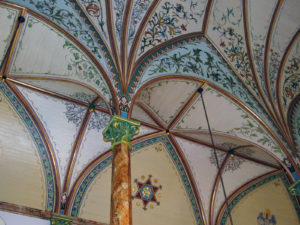 The first church we visited was the Nativity of Mary, Blessed Virgin, in High Hill known as “the Fabergé egg” or “the queen” of Texas’ painted churches. Built in 1906, the red-brick Gothic Revival church is packed to the gills with statues of saints, an elaborate altar, a chandelier, a pipe organ, Stations of the Cross imported from Italy, and a marble reproduction of Michelango’s Pieta enhanced with paint. The apse dome is awash in a subtle periwinkle blue, accented in gold leaf. Tromp l’oeil abounds; the faux marble was painted with turkey feathers. Intricately detailed stained-glass windows glow in the afternoon sun. A major conservation and restoration project was completed in 2011. Following our tour, we enjoyed a delicious lunch, prepared by chef Garrett Pettit from Sengelmann’s Hall in Schulenburg, in St. Mary’s historic wooden parish hall, thankfully air-conditioned.
The first church we visited was the Nativity of Mary, Blessed Virgin, in High Hill known as “the Fabergé egg” or “the queen” of Texas’ painted churches. Built in 1906, the red-brick Gothic Revival church is packed to the gills with statues of saints, an elaborate altar, a chandelier, a pipe organ, Stations of the Cross imported from Italy, and a marble reproduction of Michelango’s Pieta enhanced with paint. The apse dome is awash in a subtle periwinkle blue, accented in gold leaf. Tromp l’oeil abounds; the faux marble was painted with turkey feathers. Intricately detailed stained-glass windows glow in the afternoon sun. A major conservation and restoration project was completed in 2011. Following our tour, we enjoyed a delicious lunch, prepared by chef Garrett Pettit from Sengelmann’s Hall in Schulenburg, in St. Mary’s historic wooden parish hall, thankfully air-conditioned.
2 St. Mary’s, Church of the Assumption
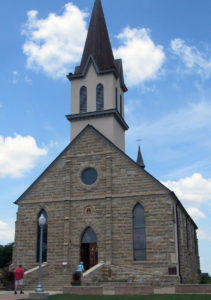
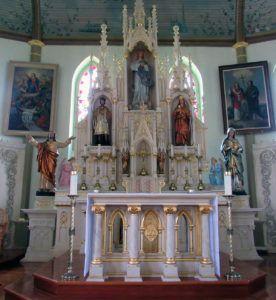 Homage to St. Mary continued at St. Mary’s, Church of the Assumption, located in Praha. The church was built in 1885 with hand-cut, locally-quarried stone. The antique chandelier hanging in the nave, made in the former Czechoslovakia, dates back to the 1800s. An extensive restoration was undertaken in 2015. The walls were restored to their original warm green color, and the beautifully hand-painted ceiling of the church was left intact. It is the work of artist Gottfried Flury (1864-1936) from Oensingen, Switzerland. He also painted the walls with wildflowers and angels.
Homage to St. Mary continued at St. Mary’s, Church of the Assumption, located in Praha. The church was built in 1885 with hand-cut, locally-quarried stone. The antique chandelier hanging in the nave, made in the former Czechoslovakia, dates back to the 1800s. An extensive restoration was undertaken in 2015. The walls were restored to their original warm green color, and the beautifully hand-painted ceiling of the church was left intact. It is the work of artist Gottfried Flury (1864-1936) from Oensingen, Switzerland. He also painted the walls with wildflowers and angels.
3 St. John the Baptist

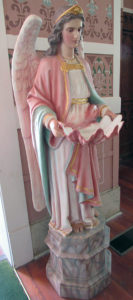
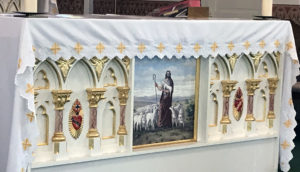 The third church on our tour was St. John the Baptist in Ammansville, one of four totally Catholic communities in Fayette County (along with Praha, Hostyn and Dubina). This was one of my two favorite churches, the other being the last church we visited. The current building is the third church on the site, the first being demolished by a hurricane in1909 and the second by fire in 1917. Area residents fortunately rescued six statues and a crucifix. Those items were placed in a newly-constructed church that was dedicated in December 1919. The outside of St. John’s is plain white Carpenter Gothic in style, but the inside is a big surprise — the walls are a beautiful shade of dusty rose. The building’s interior is a blend of cultures. St. John’s has decorative elements floor to ceiling, per the Germans, but the windows are clear with stained-glass panes at the top, to let the light in for the Czechs. The men sat on one side of the church; the women on the other. The men’s side still has hooks on the pews where they hung their hats. The side altar on the women’s side features St. Anne teaching St. Mary; the side altar on the men’s side features the Holy Family. An interesting tidbit about the inscriptions (in Czech) on the windows: DAROVALI means the window was donated by a couple; DAROVALA means the donor was a single woman, and DAROVAL means the donor was a man.
The third church on our tour was St. John the Baptist in Ammansville, one of four totally Catholic communities in Fayette County (along with Praha, Hostyn and Dubina). This was one of my two favorite churches, the other being the last church we visited. The current building is the third church on the site, the first being demolished by a hurricane in1909 and the second by fire in 1917. Area residents fortunately rescued six statues and a crucifix. Those items were placed in a newly-constructed church that was dedicated in December 1919. The outside of St. John’s is plain white Carpenter Gothic in style, but the inside is a big surprise — the walls are a beautiful shade of dusty rose. The building’s interior is a blend of cultures. St. John’s has decorative elements floor to ceiling, per the Germans, but the windows are clear with stained-glass panes at the top, to let the light in for the Czechs. The men sat on one side of the church; the women on the other. The men’s side still has hooks on the pews where they hung their hats. The side altar on the women’s side features St. Anne teaching St. Mary; the side altar on the men’s side features the Holy Family. An interesting tidbit about the inscriptions (in Czech) on the windows: DAROVALI means the window was donated by a couple; DAROVALA means the donor was a single woman, and DAROVAL means the donor was a man.
4 Sts. Cyril and Methodius
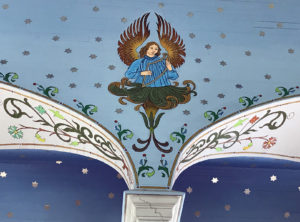
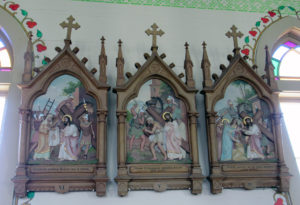 The final church we visited was Sts. Cyril and Methodius in Dubina. I was not familiar with these saints, but learned that Cyril (826-869) and Methodius (815–885) were two brothers who were Byzantine Christian theologians and missionaries, known as the “Apostles to the Slavs.” Dubina was the first settlement in Texas to be founded entirely by Czech-Moravians. The original church, built in 1876, was destroyed by a hurricane in 1909. The new church was constructed in 1912. The exterior is white Carpenter Gothic, topped by an iron cross salvaged from the remains of the old church. Apparently the same blueprints were used for both St. John’s (Ammansville) and Sts. Cyril & Methodius (Dubina), as the exteriors are almost identical. The interior of Sts. Cyril and Methodius is a mishmash of folk art and elaborate baroque paintings and statuary, yet somehow it all works together. Religious statuary is found throughout the church with elaborately carved wood Stations of the Cross on the walls.The white walls feature folk art stenciling in vivid colors. The ceiling is robin’s-egg-blue with beautiful stenciling and hand-painted angels, stars and floral vines, with an emblem of the parish in the central nave vault above the apse. We were honored to have a personal history of the church delivered by Judge Ed Janecka of Fayette County. He told us that in 1952 parishioners
The final church we visited was Sts. Cyril and Methodius in Dubina. I was not familiar with these saints, but learned that Cyril (826-869) and Methodius (815–885) were two brothers who were Byzantine Christian theologians and missionaries, known as the “Apostles to the Slavs.” Dubina was the first settlement in Texas to be founded entirely by Czech-Moravians. The original church, built in 1876, was destroyed by a hurricane in 1909. The new church was constructed in 1912. The exterior is white Carpenter Gothic, topped by an iron cross salvaged from the remains of the old church. Apparently the same blueprints were used for both St. John’s (Ammansville) and Sts. Cyril & Methodius (Dubina), as the exteriors are almost identical. The interior of Sts. Cyril and Methodius is a mishmash of folk art and elaborate baroque paintings and statuary, yet somehow it all works together. Religious statuary is found throughout the church with elaborately carved wood Stations of the Cross on the walls.The white walls feature folk art stenciling in vivid colors. The ceiling is robin’s-egg-blue with beautiful stenciling and hand-painted angels, stars and floral vines, with an emblem of the parish in the central nave vault above the apse. We were honored to have a personal history of the church delivered by Judge Ed Janecka of Fayette County. He told us that in 1952 parishioners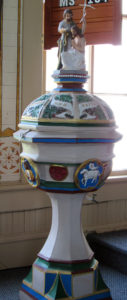 decided the old church needed updating, so they painted over the brilliant colors and bountiful illustrations that covered the walls and ceiling. A few years later he noticed that when the sun streamed in at a certain angle, he could faintly see colors and designs beneath the whitewashed walls. His dad told him what had happened. “My dad was one of those who painted over it, and it just hurt him to put that paint over those angels,” Janecka said. “Back in the ‘50s, after World War II, people really wanted modern. They just wanted to get rid of some of the old past.Our grandfathers built the things, our fathers destroyed a lot of them, and we’re now trying to repair.” In 1983 the church’s parishioners decided to restore the walls and ceilings. Thus began a long and tedious restoration process, undertaken each Sunday after services by the parishioners themselves. I loved this church!
decided the old church needed updating, so they painted over the brilliant colors and bountiful illustrations that covered the walls and ceiling. A few years later he noticed that when the sun streamed in at a certain angle, he could faintly see colors and designs beneath the whitewashed walls. His dad told him what had happened. “My dad was one of those who painted over it, and it just hurt him to put that paint over those angels,” Janecka said. “Back in the ‘50s, after World War II, people really wanted modern. They just wanted to get rid of some of the old past.Our grandfathers built the things, our fathers destroyed a lot of them, and we’re now trying to repair.” In 1983 the church’s parishioners decided to restore the walls and ceilings. Thus began a long and tedious restoration process, undertaken each Sunday after services by the parishioners themselves. I loved this church!
Tour Closing — Sengelmann Dance Hall
Our day continued with a visit to the historic Sengelmann Dance Hall inSchulenburg. Built in 1894, this men’s-only saloon was a popular stopping-off point for travelers between Houston and San Antonio, standing as a cultural hub in downtown Schulenburg until it closed in the 1940s. Dana Harper, a Houston native, bought the historic building in 2007. Few residents of Schulenburg realized it had once been a dance hall — it was last a Western Auto store. Fortunately, much of the hall’s original architectural features remained intact. The original plank flooring, carved marble pillars (with bullet holes from brawls) and pressed tin ceilings were in great shape, and the upstairs was virtually untouched. When Dana had the paint removed, to everyone’s surprise it exposed the original decorative stenciling on the walls, now prominently featured alongside the original woodwork. Carpenters meticulously recreated the original mahogany bar from old photographs. Sengelmann’s re-opened in 2009, and was awarded a National Preservation Award in 2010. NAGA past-president Katrina Packard graciously hosted our group to “heavy hors d’oeuvres” at the dance hall.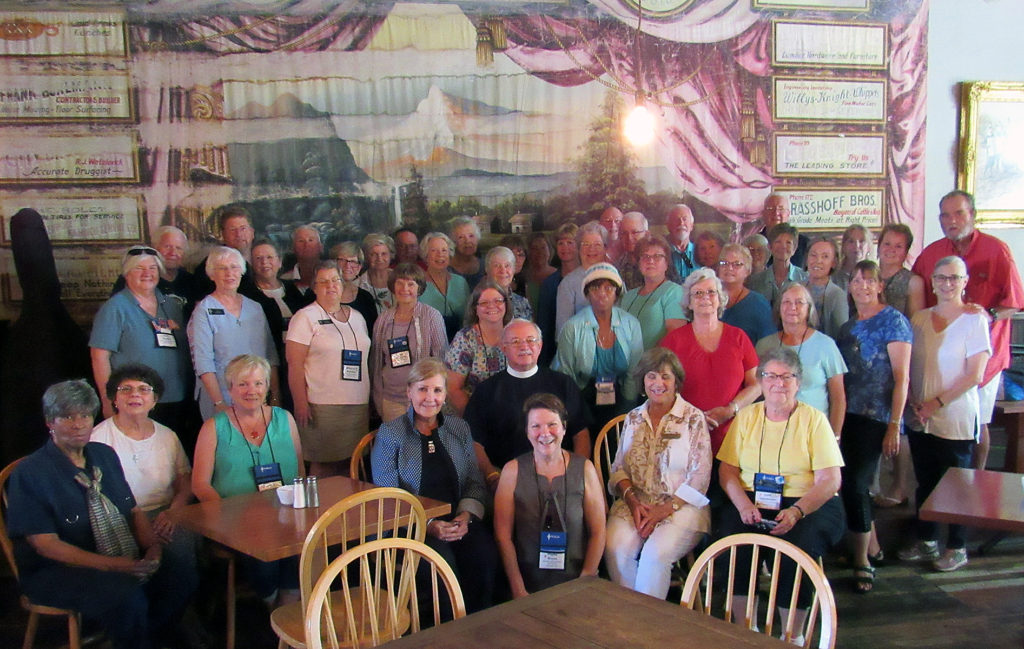
Throughout the day, I was constantly being reminded of all the themes of our Triennial program – hospitality, liturgical art, prayer, and making the ordinary extraordinary. Was this confluence of themes by design, or coincidental, or a “God thing?” Maybe a little bit of all three, but I think mostly the latter!
Peggy Curlin, Diocese of North Carolina, Christ Church, Charlotte

NAGA Triennial: A Blog « National Altar Guild Association says:
[…] On Wednesday, we were fortunate to enjoy a day-long tour of the painted churches of Texas. The artwork in each of the churches we toured was outstanding! (read about our tour here.) […]